A point also not made totally clear....
It's not completely certain whether some of the Celtic/Germanic long knives are/were actually weapons.
Clearly the Hjorspring ones were weapons from the find context. However, the celtic knives could easily be tool as much as sidearm. Most of these were found in grave contexts, however often you also have other luxury goods, sacrificed animals, wine-drinking gear, etc. They're not always very big, and even the shape and cross section I don't believe to be definitive---something good for carving meat is shaped to efficiently slice flesh, and could therfore look weapon-ish
Even the large ones could be more along the lines of ostentatious carving knives, given the prominence of the feast and the Hero's right to the select portions of the roast animal (boar). So even the bigger celtic ones might be something like a really big carving knife, that shows status.
These curved knives are also not omnipresent in warrior graves (unlike a spear or some such), so, who knows?
| Shane Allee wrote: |
| Nate may still have a pic I sent him of the wooden mock-up I made which he could post, but I have to do my line drawings on graph paper and that would just make it way too easy.
The main reason for doing the mock-up in the first place was just to do the grip to make sure my hands would fit. Rick even asked upon first seeing it if I could fit my hand in it, that it looked small. They do fit very nicely though. Shane |
Below is a pic of the rough mock-up that Shane did, it's in size and proportion, though his new mock-up is more refined.
This is with a normal sized Tsuba and (4", 4 1/2" ?) grip that was the grip for Problem Child.
It is quite small and handy, with a snug hilt. The curvature of the hilt really helps in the handling feel, even more than the grip of my old kukri I have laying around here somewhere.
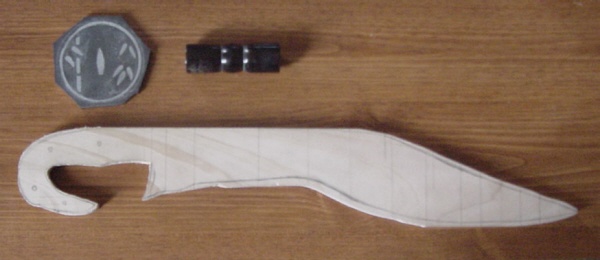
Ok then I just posted this pic on a other board here.
But I ques it also belongs here...
Maybe the right one is another candidate for ancester of the Falcata..?
And what about the falcata on the left?
Dus it look like something, a good replica, reproduction for example, or is it way to ornated..?
 Attachment: 31.94 KB
Attachment: 31.94 KB
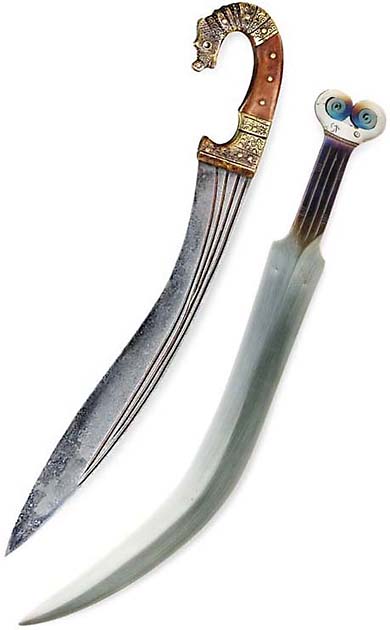
But I ques it also belongs here...
Maybe the right one is another candidate for ancester of the Falcata..?
And what about the falcata on the left?
Dus it look like something, a good replica, reproduction for example, or is it way to ornated..?

Here is a very speculative idea. As I understand it, the kopis has an Egyptian antecedent. Boomerangs were widely used in ancient Egypt. Boomerangs in Australia historically are known to be used as swords. Many were never thrown. From descriptions of fights the strokes sound much like the motion of a kopis/kuhkri. Is it possible that the kopis has a wooden boomerang ancestor?
| Tim Fohl wrote: |
| Here is a very speculative idea. As I understand it, the kopis has an Egyptian antecedent. Boomerangs were widely used in ancient Egypt. Boomerangs in Australia historically are known to be used as swords. Many were never thrown. From descriptions of fights the strokes sound much like the motion of a kopis/kuhkri. Is it possible that the kopis has a wooden boomerang ancestor? |
Hi Tim...
Welcome to the forum. It's good to have you here.
At first I thought is was a crazy idea. However, the more I think of it, I have seen Egyptian hieroglyphics of Asiatics who are carrying "throw sticks" which look much like boomerangs yet have a handle like a Khopesh. From what I understand these throwsticks were so common among the Asiatic traders that it became the hieroglyph for them. The Khopesh was also known among the Asiatics from Canaan and Mesopotamia. From what I'be heard, desert woods (i.e. Acacia) are very hard and dense. So it could make a relatively hard and sharp edge.
Interesting idea... thanks for posting.
take care.
ks
Hey, if you're going to club people to death, you might as well do it in style. Actually, I was like Kirk in thinking this theory a bit strange at first, but I don't why it couldn't be true, either. Thanks Tim, that is certainly something interesting to contemplate.
-Grey
-Grey
Thanks for the consideration. Warming to the subject, I took a look at Richard Burton's "Book of the Sword". He devotes quite a bit of space to this idea, or at least a lot of similar thoughts. I haven't really studied it completely yet but there is a lot of interesting material there.
I happened to see this topic,this is a interesting question I have thought about for a long time.But I started from the searching for the source of Yatagan.
there is a kind of sword spread form pre-Roman Hispania,to Greek,Turk,Caucasia,Afghanistan,and other central asia countries,east even to China.
they have two obvious characteristics:
1.forward-curving blade
2.animal head hilt
the cultural source and actual spread route is still uncertain,because these areas are the route Alexandria the Great march east and also the southen border of the ancient nomadism zone form Siberia to Black Sea where hordes moved around from prehistoric era.
here are some archaeological informations in China ,maybe can expand the horizon on this topic.
there is a kind of sword spread form pre-Roman Hispania,to Greek,Turk,Caucasia,Afghanistan,and other central asia countries,east even to China.
they have two obvious characteristics:
1.forward-curving blade
2.animal head hilt
the cultural source and actual spread route is still uncertain,because these areas are the route Alexandria the Great march east and also the southen border of the ancient nomadism zone form Siberia to Black Sea where hordes moved around from prehistoric era.
here are some archaeological informations in China ,maybe can expand the horizon on this topic.
Last edited by Read Hill on Tue 26 Dec, 2006 11:04 am; edited 3 times in total
dagger-axes and knife ,1600BC-1500BC,unearthed in Henan Province ,China ,
Great changes the culture relics of the fourth phase of Erlitou culture,Zhu Xiao-jun
 Attachment: 14.71 KB
Attachment: 14.71 KB
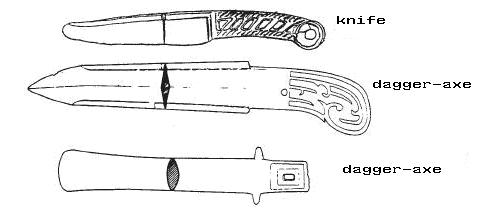
I
Great changes the culture relics of the fourth phase of Erlitou culture,Zhu Xiao-jun

I
Last edited by Read Hill on Tue 26 Dec, 2006 10:25 am; edited 2 times in total
Daggers with animal head hilt ,1200BC, unearthed in Henan Province,China,
 Attachment: 41.11 KB
Attachment: 41.11 KB
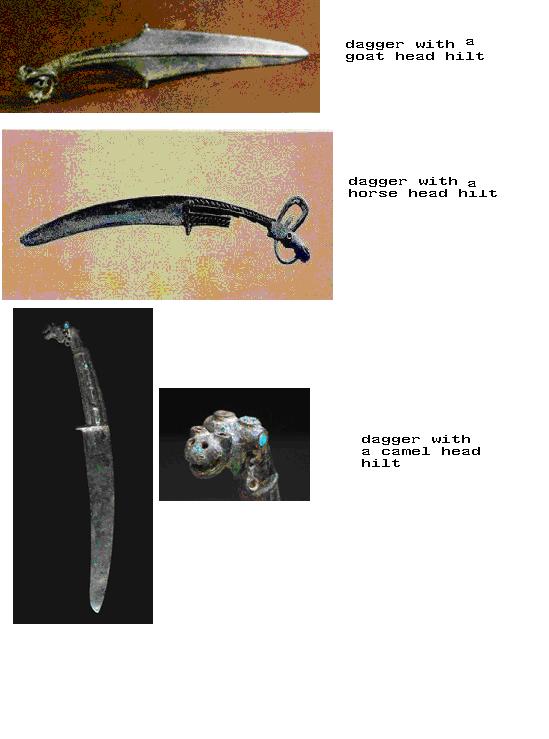
II

II
Last edited by Read Hill on Tue 26 Dec, 2006 10:26 am; edited 3 times in total
sword ,1000BC-900BC,unearthed in Beijing,China
 Attachment: 42.78 KB
Attachment: 42.78 KB
III [ Download ]
III [ Download ]
dagger ,800BC, unearthed in inner Mongolia,China
 Attachment: 100.03 KB
Attachment: 100.03 KB
IV [ Download ]
IV [ Download ]
daggers,100BC, unearthed in inner Mongolia
 Attachment: 84.04 KB
Attachment: 84.04 KB
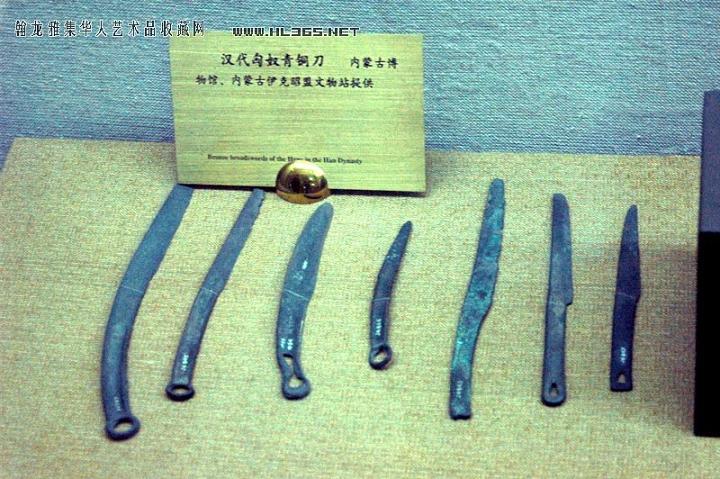
V
 Attachment: 37.16 KB
Attachment: 37.16 KB
locations where these relics are unearthed [ Download ]

V
locations where these relics are unearthed [ Download ]
Last edited by Read Hill on Tue 26 Dec, 2006 10:27 am; edited 2 times in total
Read,
Thanks for these pictures. Unlike some other forums, we allow users to attach more than one picture per post. It saves page space and the annoyance of having to scroll through many individual posts with only one picture. Thanks!
Thanks for these pictures. Unlike some other forums, we allow users to attach more than one picture per post. It saves page space and the annoyance of having to scroll through many individual posts with only one picture. Thanks!
Those daggers and working knives with animal heads remind me of artifacts found in the region between the western mountains of China,(Altai and others) and the Black Sea. They would seem to come under the genre called the "animal style". Very interesting. Thanks.
Where are the items kept?
Where are the items kept?
Hi Read...
Thanks for the interesting pictures and ideas... And welcome to the forum!
Central Asia really seems to be a no-man's-land for spathologists, but there are some really interesting forms that echo the broader cultural influence as people groups went progressively west onto the steppes with further cultural diffusion into Europe. Very interesting stuff.... thanks for contributing.
ks
Thanks for the interesting pictures and ideas... And welcome to the forum!
Central Asia really seems to be a no-man's-land for spathologists, but there are some really interesting forms that echo the broader cultural influence as people groups went progressively west onto the steppes with further cultural diffusion into Europe. Very interesting stuff.... thanks for contributing.
ks
| Kirk Lee Spencer wrote: | ||
...I have seen Egyptian hieroglyphics of Asiatics who are carrying "throw sticks" which look much like boomerangs yet have a handle like a Khopesh. From what I understand these throwsticks were so common among the Asiatic traders that it became the hieroglyph for them... |
I found an image of the wall paintings to which I referred in the above quote. It is from the tomb of Khnum Hotep III at the magnificent necropolis at Beni Hassan, Egypt. Dated to the 19th century. If you look carefully you can see the throwsticks. They even seem to have handles similar to those of the Egyptian and Canaanite Khopesh.
ks
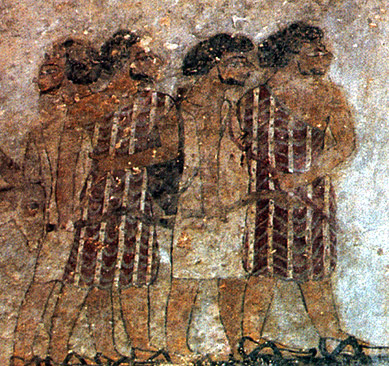
Kirk,
The guys in the tomb painting have rather non-Egyptian looking beards. Is there any information as to their origins?
The guys in the tomb painting have rather non-Egyptian looking beards. Is there any information as to their origins?
| Tim Fohl wrote: |
| Kirk,
The guys in the tomb painting have rather non-Egyptian looking beards. Is there any information as to their origins? |
I'm not Kirk, but I've seen this picture before. IIRC, these are a Semetic people, possibly Canaanites or one of the other tribal peoples of the near Middle East, such as the Hebrews.
Agreed. These men are bearded, and also are wearing very non-Egyptian robes. I would think they are from Canaan, Syria, or adjacent lands.
Page 3 of 6
You cannot post new topics in this forumYou cannot reply to topics in this forum
You cannot edit your posts in this forum
You cannot delete your posts in this forum
You cannot vote in polls in this forum
You cannot attach files in this forum
You can download files in this forum
All contents © Copyright 2003-2006 myArmoury.com — All rights reserved
Discussion forums powered by phpBB © The phpBB Group
Switch to the Full-featured Version of the forum
Discussion forums powered by phpBB © The phpBB Group
Switch to the Full-featured Version of the forum